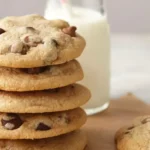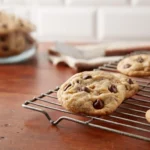Cookies are one of the most beloved baked treats worldwide, enjoyed in countless variations, from soft and chewy to crispy and crunchy.
Whether you’re a baking enthusiast or a complete beginner, creating the perfect cookie recipe from scratch is both a science and an art.
Understanding the role of each ingredient, experimenting with different combinations, and mastering the right techniques can lead to cookies that taste just the way you like them.
Unlike pre-made store-bought cookies, homemade cookies offer the flexibility to customize flavors, textures, and ingredients according to your preference.
Making cookies from scratch allows you to control every aspect, from choosing high-quality ingredients to deciding on the level of sweetness, texture, and even health-conscious alternatives.
While traditional cookie recipes follow a basic formula, a true baking enthusiast knows that fine-tuning elements such as fat content, leavening agents, and chilling time can elevate an ordinary cookie to an extraordinary treat.
This guide will walk you through every step of designing your own cookie recipe.
We will cover ingredient selection, the science behind baking, mixing methods, chilling techniques, and baking tips.
We will also explore ways to enhance flavors with unique mix-ins, seasonal variations, and dietary modifications to suit every need.
By the end, you’ll have all the knowledge needed to craft a unique cookie recipe tailored to your taste.
Whether you want a classic chocolate chip cookie, a nut-filled delight, or something completely unique, this comprehensive guide will help you achieve perfection.
Understanding the Basics: Choosing Your Cookie Type
What Kind of Cookie Do You Want?
The first step in crafting a cookie recipe is deciding on the texture and flavor profile you desire.
Do you prefer cookies that are soft and chewy, crispy and crunchy, or thick and cake-like? Each type requires a specific balance of ingredients and baking methods.
Here’s a breakdown:
- Chewy Cookies – These are dense and soft, with a slightly gooey center. They require more brown sugar, high moisture content, and melted butter.
- Crispy Cookies – Light and crunchy, crispy cookies typically have a higher ratio of white sugar and less moisture, with butter playing a crucial role.
- Soft and Cake-like Cookies – These cookies have a fluffy texture and require more eggs, less butter, and sometimes additional leavening agents such as baking powder.
- Fudgy Cookies – These cookies, often seen in brownie-like variations, are rich and dense due to a higher fat and chocolate content.
- Shortbread Cookies – Buttery and crumbly, shortbread cookies contain a high ratio of butter to flour and minimal liquid ingredients.
Once you’ve chosen your desired texture, you can begin experimenting with ingredient ratios and baking techniques to fine-tune the results.
Adjusting the balance of fats, sugars, and leavening agents can help you achieve the exact cookie texture you desire.
Essential Ingredients and Their Roles

Flour: The Foundation of Structure
Flour is the backbone of any cookie recipe. It provides structure and stability by forming a gluten network when mixed with wet ingredients.
Different types of flour can influence the texture of your cookies:
- All-Purpose Flour – The most common choice, providing a balance of chewiness and crispiness.
- Cake Flour – Results in softer, more delicate cookies with a tender crumb.
- Bread Flour – High in protein, bread flour creates a chewier texture due to stronger gluten development.
- Whole Wheat Flour – Adds a hearty, nutty flavor and a slightly denser texture.
- Gluten-Free Alternatives – Almond flour, oat flour, or coconut flour can be used to make gluten-free cookies, though they may require binding agents such as xanthan gum or eggs.
For most standard recipes, a ratio of 1 to 2 cups of flour per batch works well, but adjustments can be made based on your preferred texture.
Sugar: The Sweet Balancer
Sugar is not just for sweetness—it affects the texture, spread, and color of cookies.
The type of sugar used will determine whether cookies are crisp or chewy.
- Brown Sugar – Contains molasses, providing moisture and chewiness. Ideal for soft, chewy cookies.
- White Sugar – Produces crispier cookies by allowing the dough to spread more.
- Powdered Sugar – Often used in shortbread and delicate cookies for a smooth texture.
- Alternative Sweeteners – Honey, maple syrup, coconut sugar, or date sugar can be used for unique flavors but may affect texture.
For a standard cookie recipe, using ½ to 1½ cups of sugar will provide the right sweetness while maintaining structure.
Experimenting with a blend of white and brown sugar often yields the best results.
Fats: The Key to Moisture and Flavor
Fat contributes to flavor, tenderness, and texture. The type of fat used can alter the outcome of your cookies.
- Butter – Provides a rich flavor, promotes browning, and enhances chewiness.
- Shortening – Yields softer cookies with less spread and a slightly longer shelf life.
- Vegetable Oil – Keeps cookies moist but may not provide the same depth of flavor as butter.
- Coconut Oil – Adds a slight coconut flavor and can replace butter in dairy-free recipes.
- Nut Butters – Peanut, almond, or cashew butter can add extra richness and flavor.
The typical fat ratio is ½ to 1 cup per batch, but variations allow for different textures. A combination of fats can also lead to more balanced results.
Eggs: The Binder and Leavening Agent
Eggs provide structure, moisture, and help with leavening. Adjusting the number of eggs can influence the cookie’s texture.
- One egg – Creates a denser, chewier cookie.
- Two eggs – Results in a softer, more cake-like texture.
- Egg Substitutes – Applesauce, flaxseed meal, mashed banana, or yogurt can replace eggs in vegan or allergy-friendly recipes.
Leavening Agents: Achieving the Perfect Rise
Leavening agents help cookies rise and affect texture.
- Baking Soda – Creates spread and chewiness by reacting with acidic ingredients.
- Baking Powder – Produces a softer, cake-like texture.
- Yeast – Rarely used in cookies but can create a unique, airy texture.
- Cream of Tartar – Helps stabilize egg whites in meringue-based cookies.
A good starting point is ½ to 1 teaspoon per batch, depending on the type of cookie.
ALSO READ: How to Make Homemade Bread with Simple Ingredients
Customizing Your Recipe
Once you’ve mastered the basics, you can get creative:
- Add-ins – Chocolate chips, dried fruit, nuts, or caramel chunks.
- Flavor Enhancers – Espresso powder, citrus zest, or spices.
- Specialty Flours – Experiment with rye, whole wheat, or almond flour.
- Dietary Adjustments – Vegan, keto, and gluten-free variations.
ALSO READ: How to Organize Your Kitchen for Maximum Efficiency
Conclusion
Creating the perfect cookie recipe from scratch involves understanding ingredient functions, experimenting with textures, and refining techniques.
By following this guide, you can develop a unique cookie recipe tailored to your taste.
Whether you want a classic chocolate chip cookie or an innovative new creation, the possibilities are endless.
So, grab your ingredients, start mixing, and bake your way to cookie perfection!






